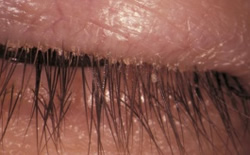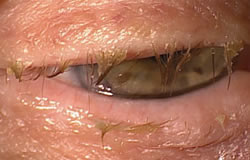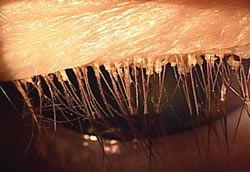
Blepharitis
Blepharitis description
Seborrheic blepharitis
Staphylococcal blepharitis
Demodex blepharitis
Blepharitis treatment
Blepharitis description
Blepharitis is a chronic inflammation of the edges of the eyelids. The margins of the eyelids usually thicken and look red. It may also cause redness of the eyes, itching and a gritty irritation. Lubricating eye drops do little to improve the condition.
Blepharitis is often confused with conjunctivitis or "dry eye" due to its gritty sensation. It can also be confused with an allergic response to dust mite faeces and other allergens. If your red eyelids are caused by an allergy, prescription ocular antihistamines and over-the-counter ocular antihistamines can bring almost immediate relief. Treatment of the underlying root causes of the allergy.

Seborrheic blepharitis
Seborrheic blepharitis is the most common type of blepharitis. It is usually associated with seborrheic dermatitis which infects the scalp, lashes, eyebrows, the folds around the nose, and the ears. People usually get it when they have a seborrheic dermatitis infection on the scalp that eventually spreads.
Staphylococcal blepharitis

Staphylococcal blepharitis is caused by infection of the skin on the outside of the eyelid by Staphylococcal bacteria. As the infection progresses, the sufferer may begin to notice a foreign body sensation, matting of the lashes, and burning. Usually a doctor will prescribe topical antibiotics for staphylococcal blepharitis, as this is an acute condition and should heal quickly. The condition can sometimes lead to a chalazion, cyst or sty.
Demodex blepharitis
Demodex blepharitis is common, but often unacknowledged by the medical profession. This type of blepharitis is caused by a mite infestation, usually by demodex mites. These mites live in hair follicles and oil glands, and can be found in nearly all of people aged over 60. Less than one third of children have mites. Tea tree oil blended with castor oil, and tea tree oil shampoo, are the most effective treatment to kill these small (up to 0.2 mm) mites.

When blepharitis is caused by a mite infestation, you can usually observe cuffing or collarettes around the base of the lashes.
Blepharitis treatment
Establish a daily routine of lid margin hygiene. After some weeks or months and after noticeable improvement, perhaps once or twice a week may be sufficient. You will need to experiment to find what suits you. Too frequent, and you irritate the eyelids and remove the natural oils. Not frequently enough, and there is a build-up of crust and gunk between the lashes and on the edges of the lids. This is something you may need to do for months, years or even the rest of your life. Blepharitis is often a chronic condition that is prone to recurring.
Here is a lid margin hygiene routine:
1. Soften the lid margin debris and oils. Apply a warm wet compress on the lids - cotton wool balls dipped in warm water, a clean washcloth or a makeup removal pad. Leave it on for a minute or two. I use comfortably warm or tepid water, especially in the summer, as I have found that hot water causes irritation and inflammation. In the winter perhaps use warm water. You will need to experiment to find what temperature is most soothing for you.
2. Mechanical removal of lid margin debris. Use clean fingers or the balls / washcloth / pad to gently massage along the lid margins for a few seconds while eyes are closed. Gently wipe a couple of times to remove the crusting and debris. Some people put a little baby shampoo or liquid castile soap on the pad to make it more effective at removing the crusting. However, too much soap or shampoo may remove the essential oily layer of the eyes own tear film and create further problems with dry eye discomfort.
3. When the blepharitis is caused by mites, tea tree oil is usually the most effective treatment. However, you cannot put neat tea tree oil on the eyelids, it would burn painfully and may damage the eye. It must be diluted and applied carefully. You can buy blepharitis wipes that are impregnated with only some of the TTO components, so they do not burn.
4. Antibiotic reduction of lid margin bacteria. Grow Youthful's visitors have tried several remedies to reduce the harmful bacteria and soothe the inflammation (see Remedies).
5. Re-establish a balance of good probiotic bacteria on your eyelashes and eyelids. Sour, not sweet, home-made water kefir is a rich source of a variety of Lactobacillus subspecies, and may be taken daily and also a few drops applied to the eyelashes and eyelid margins. Apply it after cleaning, and leave it on the lids - do not rinse it off. If you get a drop of water kefir in your eye, it may feel comfortable, or it may sting slightly if you are using an old and slightly acid brew. Wipe with a towel if necessary, but do not rinse it.
Castor oil is an alternative to sour home-made water kefir. Smear half a drop on a clean finger, and gently wipe it onto the eyelashes and eyelid margins. I would not do this as a long-term treatment, but it is effective when done a couple of times per week.
Avoid the use of eye make-up until symptoms subside.
